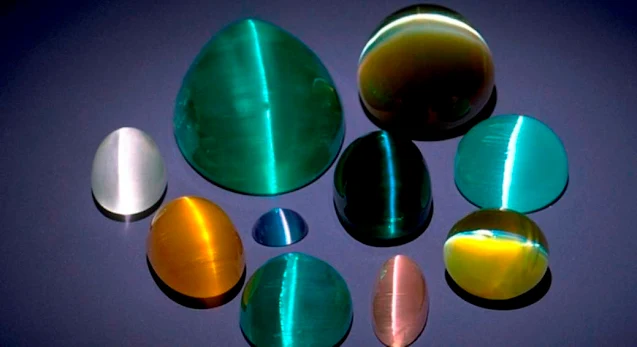Cat's Eye Gemstones: Chatoyancy
Cat's Eye Effect, also called Chatoyancy, is an optical phenomenon, possessed by certain minerals in reflected light, in which a movable wavy or silky sheen is concentrated in a narrow band of light that changes its position as a mineral is turned. It results from the reflection of light from minute, parallel fibers, cavities or tubes, or needlelike inclusions within the mineral.
The effect may be seen on a cabochon-cut gemstone, either distinct and well defined (such as the narrow, light-colored streak in a fine chrysoberyl cat's-eye) or less distinct (such as in the usual tourmaline or beryl cat's-eye).
The name “chatoyance” originates from the French word “chatoyer,” which means “to shine like a cat’s eye.” The analogy also matches the way a cat’s pupils will narrow to a thin slit under bright light. Cat's eye effect is an optical reflectance effect seen in certain gemstones.
The precipitates that cause chatoyance in chrysoberyl are the mineral rutile, composed mostly of titanium dioxide. Examined samples have yielded no evidence of tubes or fibres. The rutile precipitates all align perpendicularly with respect to cat's eye effect. It is reasoned that the lattice parameter of the rutile matches only one of the three orthorhombic crystal axes of the chrysoberyl, resulting in preferred alignment along that direction.
Gem species known for this phenomenon include the aforementioned quartz, chrysoberyl, beryl (especially var. aquamarine), charoite, tourmaline, labradorite, selenite, feldspar, apatite, moonstone, thomsonite and scapolite amongst others. Glass optical cable can also display chatoyancy if properly cut, and has become a popular decorative material in a variety of vivid colors.
How is Cat's Eye formed
Scientists studying pseudomorphs put a piece of South African tiger’s eye under a scanning electron microscope. They found no evidence that tiger’s eye was a pseudomorph, but rather proposed it was formed through a discontinuous crack-seal mechanism.
The crack-seal mechanism that forms tiger's eye begins when a quartz rock containing some crocidolite cracks. Water containing the minerals necessary to make both quartz and crocidolite seep into the crack. Quartz begins to grow on the crack surface, while crocidolite fibers begin to grow from pieces of crocidolite that are on the crack surface. The crack area fills with new material and then the rock cracks again, usually in a sliding motion along the existing crack surface because it is weaker than other areas.
The new crack fills the same way, but the crocidolite fiber is slightly offset because of the crack shear. This process forms bands of quartz with diagonal, discontinuous crocidolite fibers creating hawk's eye. After some of the iron in the crocidolite oxidizes, the material becomes the familiar shades of brown and gold of tiger's eye.
Famous examples of this type of sheen are Chrysoberyl Cat's-Eye (or "Cymophane") and Tiger's-Eye (Quartz with asbestos fibers).
 |
| Unlike other cat’s-eye gemstones Chrysoberyl can exhibit a very sharp and distinct cat’s-eyes under almost any kind of light. (Photo by: Tino Hammid) |
Gems Exhibit Chatoyance
Chrysoberyl: This gemstone, particularly the cat's eye variety, is renowned for its sharp and distinct chatoyant band, often milky white against a honey-colored background.
Tiger's eye: This popular gemstone displays a chatoyant band that shimmers with a golden or brown luster, reminiscent of a tiger's stripes.
Alexandrite: This color-changing gem can also exhibit chatoyancy, adding another layer of intrigue to its mesmerizing properties.
Beyond the big three: Don't be fooled by these headliners, the chatoyancy party extends further! Here are some other gemstones that can showcase this mesmerizing effect:
Apatite: This versatile gemstone comes in various colors, and some specimens display a chatoyant glow, particularly blue and green varieties.
Moonstone: This gemstone is known for its adularescence, a milky schiller effect. However, some moonstones also exhibit chatoyancy, adding another dimension to their beauty.
Even sapphires and rubies: Under rare circumstances, even these precious stones can exhibit chatoyancy, making them truly unique finds.
Charoite: This captivating gemstone features a swirling pattern of chatoyancy in shades of purple, lavender, and green, creating a mesmerizing visual experience.
These are just a few examples of the many gemstones that showcase the captivating chatoyancy effect. Each stone offers its own unique beauty and personality, making them prized by collectors and jewelry enthusiasts alike.
 |
| Cat's Eye Minerals Collection. Photo: Frans Jonker G. |
Chatoyancy represents a captivating interplay of geological and optical factors, giving rise to a distinctive visual phenomenon observed in certain minerals. The scientific examination of chatoyancy contributes not only to our understanding of mineralogical processes but also enhances the appreciation and valuation of gemstones exhibiting this unique optical effect.










